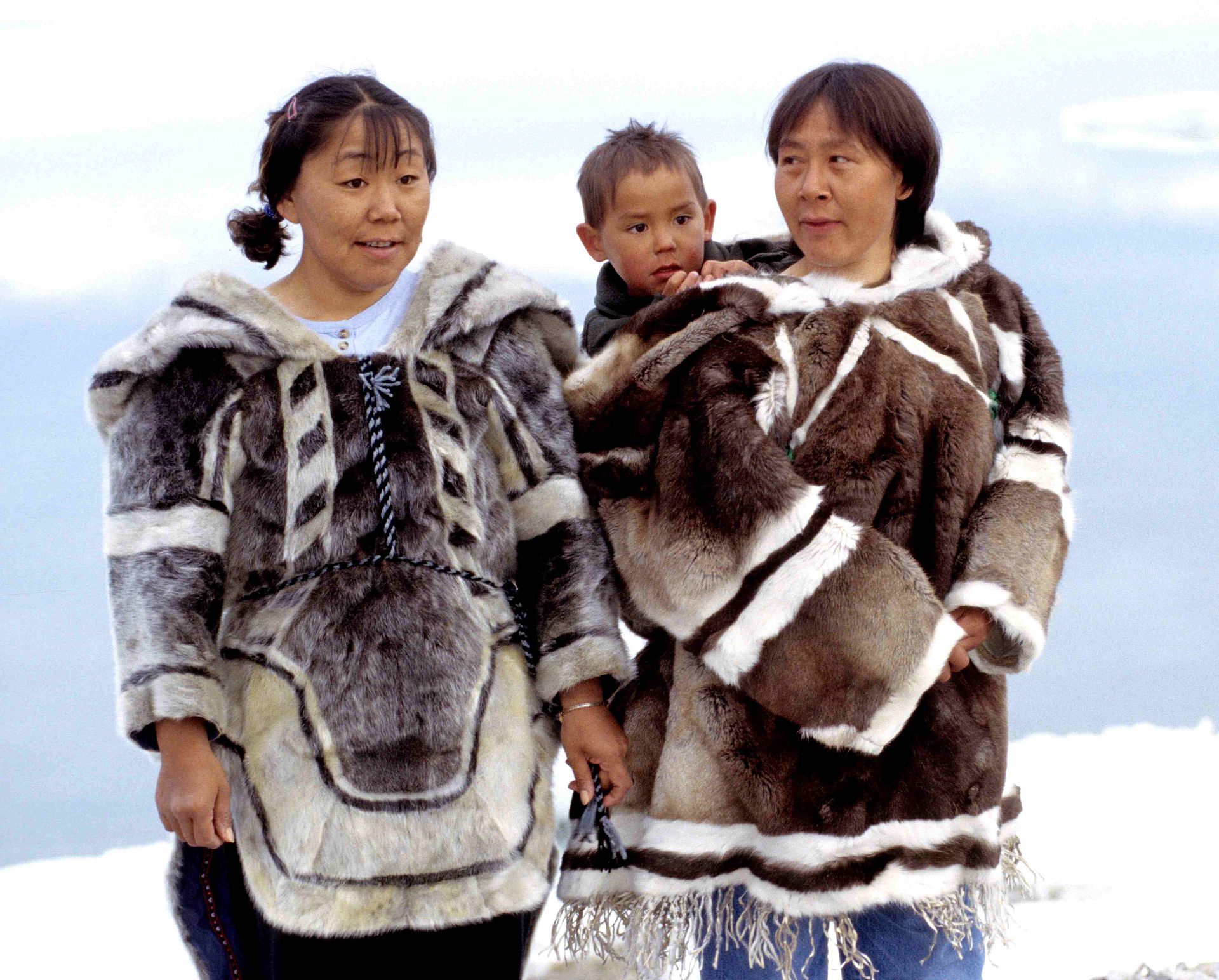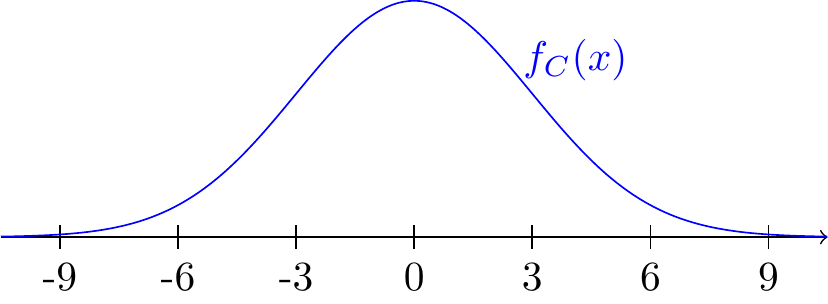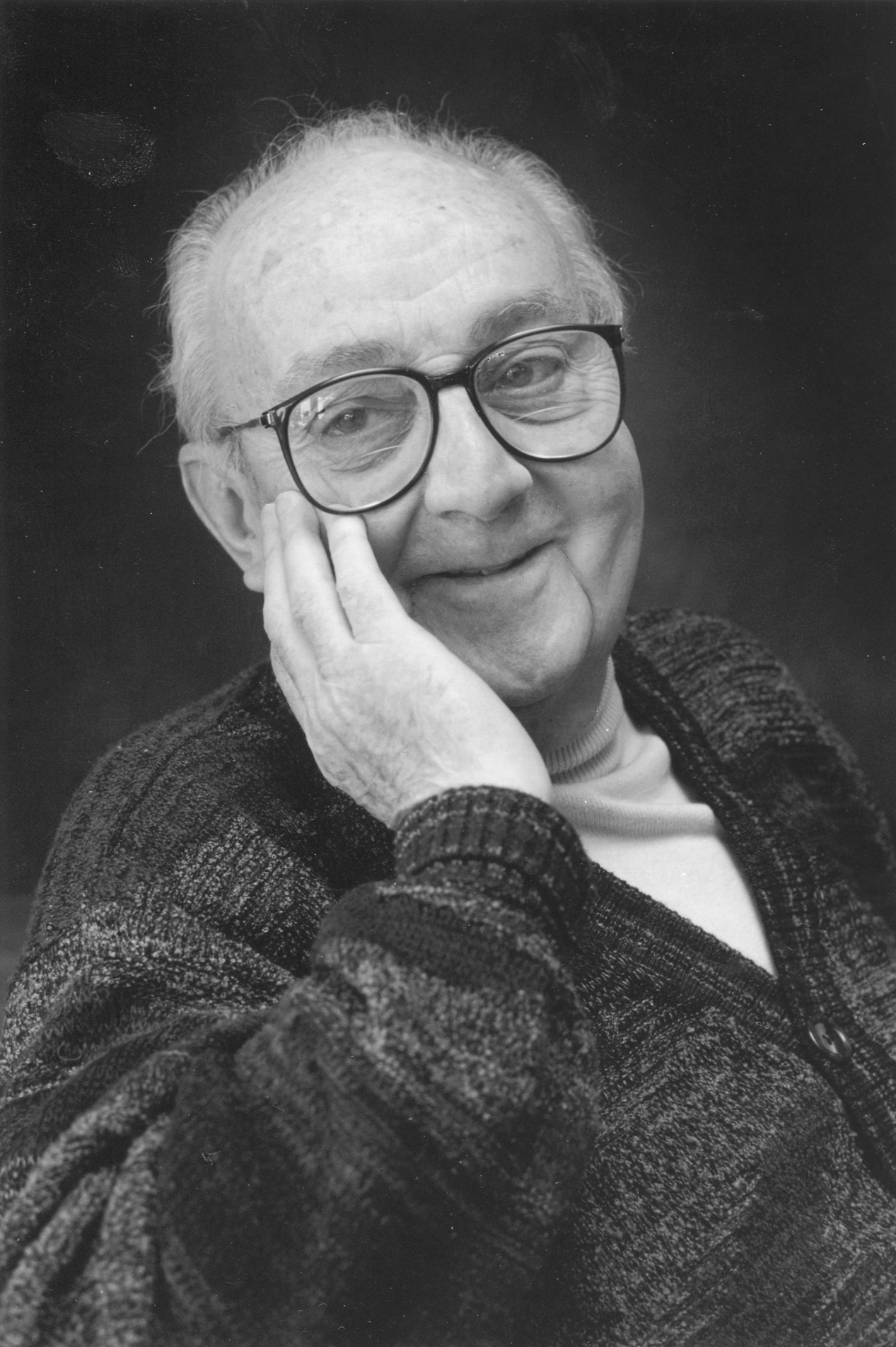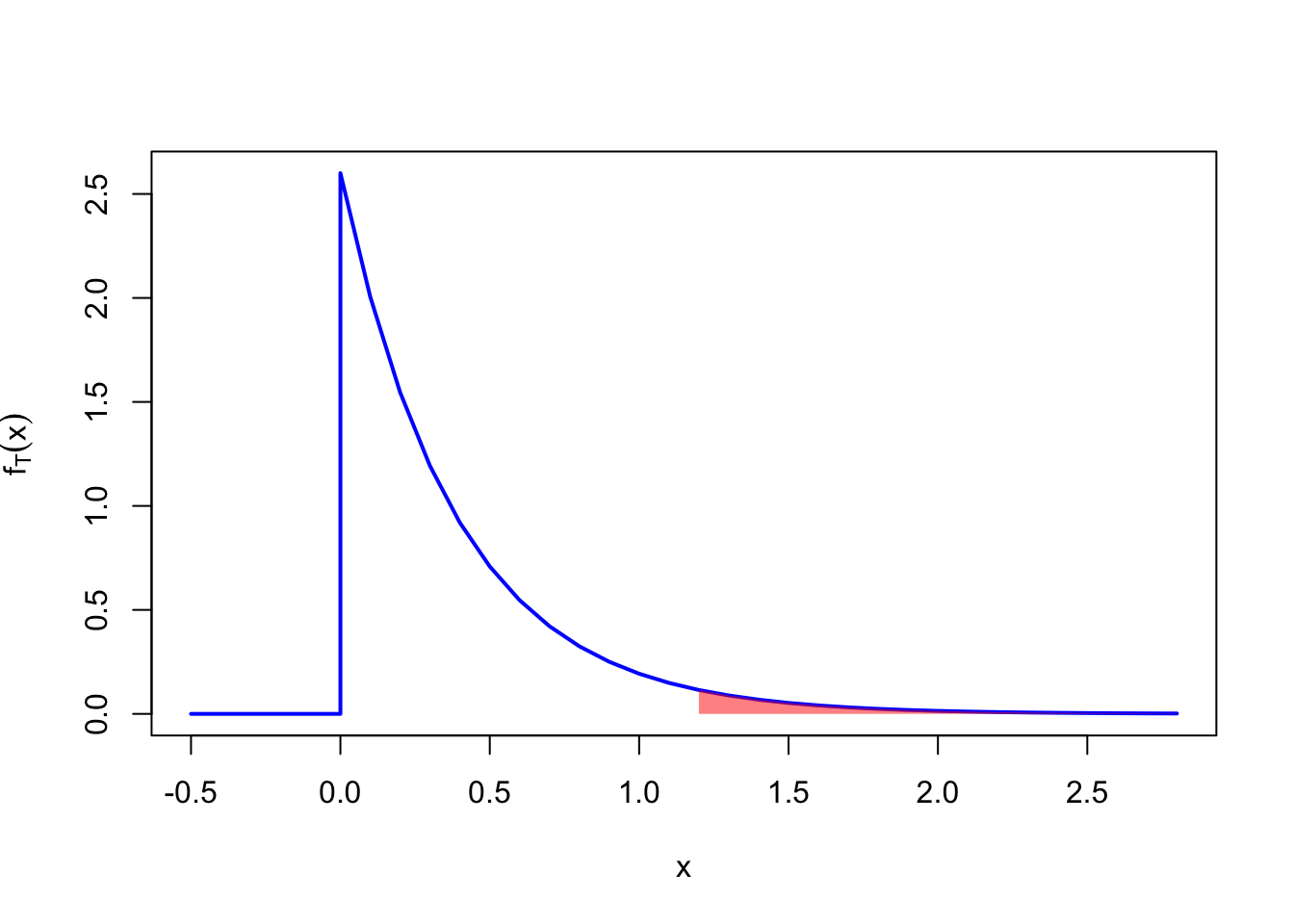
18 Random Variables
$$
$$
\[ \def\mean{\textcolor{red}{1.2}} \]
The random variables that we have encountered so far, like
- your net earnings if you bet $1 on the number 23
- the number of friends who draw their own name in Secret Santa
have all been discrete. That is, these random variables can only take on values in a countable set.
Now, consider a random variable \(X\) that represents the distance of one of Jackie Joyner-Kersee’s long jumps (Figure 18.1). Even a professional’s jumps will vary from attempt to attempt; when Joyner-Kersee won gold at the 1988 Seoul Olympics, her three successful long jump attempts were 7.00, 7.16, and 7.40 meters. (The last jump earned her the gold medal and remains the Olympic record.)
Suppose that we model \(X\) as “equally likely” to be any distance between \(6.3\) and \(7.5\) meters. If we model \(X\) at a granularity of \(0.1\) meters, then \(X\) can be represented as a discrete random variable, whose PMF is shown in Figure 18.2.
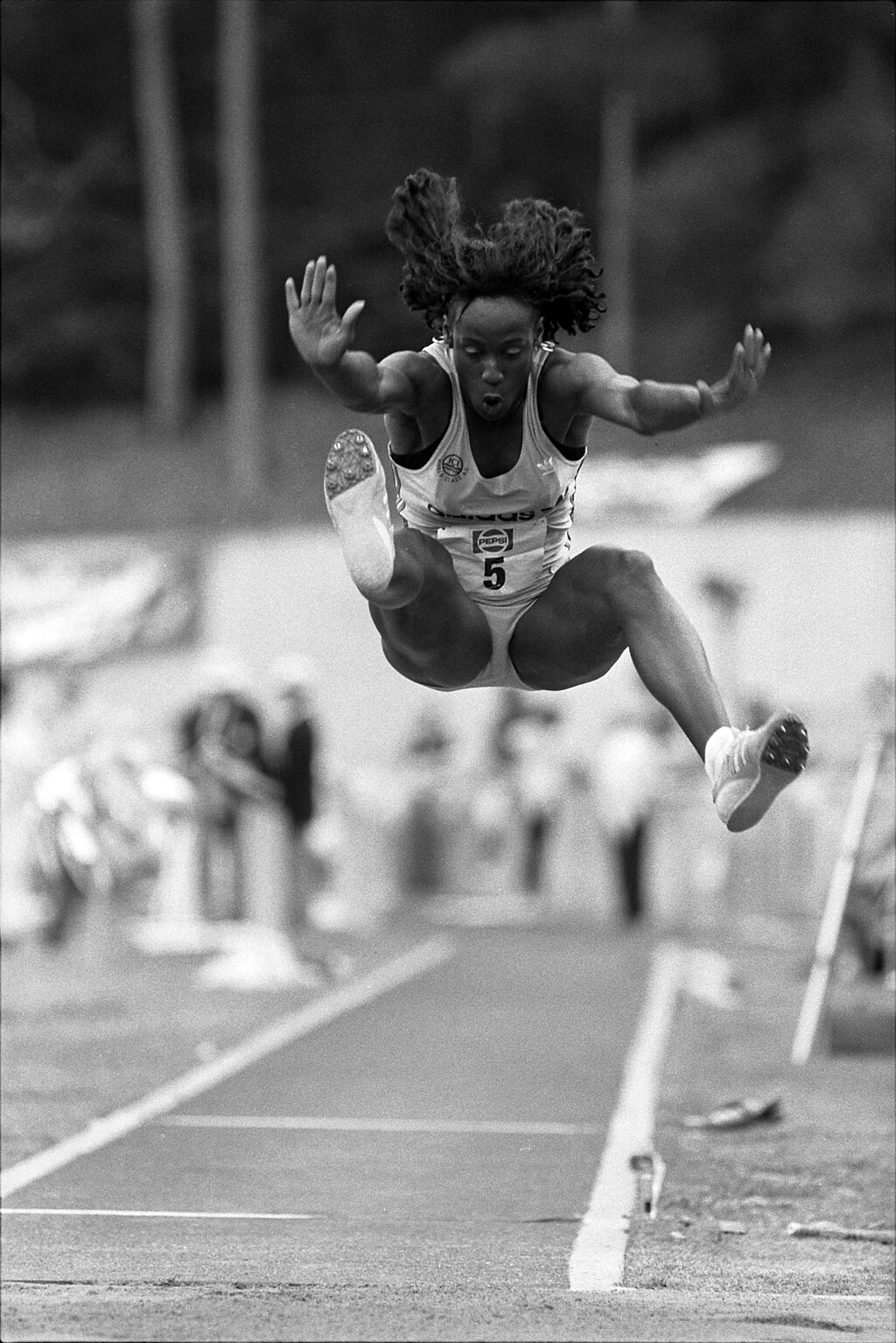

The probability \(P(7.0 \leq X \leq 7.3)\) is calculated by summing the probabilities highlighted in orange. Since there are 13 possible values, all equally likely, this probability is \(\frac{4}{13}\), based on the model in Figure 18.2.
We can improve the precision of our model by increasing the granularity to \(0.05\) meters, as shown in Figure 18.3. Now the probability \(P(7.0 \leq X \leq 7.3)\) is \(\frac{7}{25}\)

But there is no reason to stop here. We can always obtain a more precise model by increasing the granularity. As we do so, the probability of each individual value gets smaller and smaller. Nevertheless, the probability of a range of values remains approximately the same.

As we make the model infinitely precise, the probability of each individual value approaches \(0\), while the probability of the range \([7.0, 7.3]\) approaches \(0.25\). This makes sense because this range represents \[ \frac{7.3 - 7.0}{7.5 - 6.3} = 0.25 \] of the total range of possible values, and all possible values are equally likely.
Clearly, random variables like \(X\) cannot be represented by a PMF, since \(P(X = c) = 0\) for every value of \(c\), yet \(P(7.0 \leq X \leq 7.3)\) is not zero. This is like the dartboard example from Chapter 3! The probability that the dart lands on any particular spot is zero, but the probability that it lands somewhere on the dartboard is certainly not zero!
Random variables like \(X\), where all real numbers in a range are possible, are called continuous. We will see that the correct way to describe continuous random variables is by a probability density function (or PDF, for short), shown in Figure 18.5.
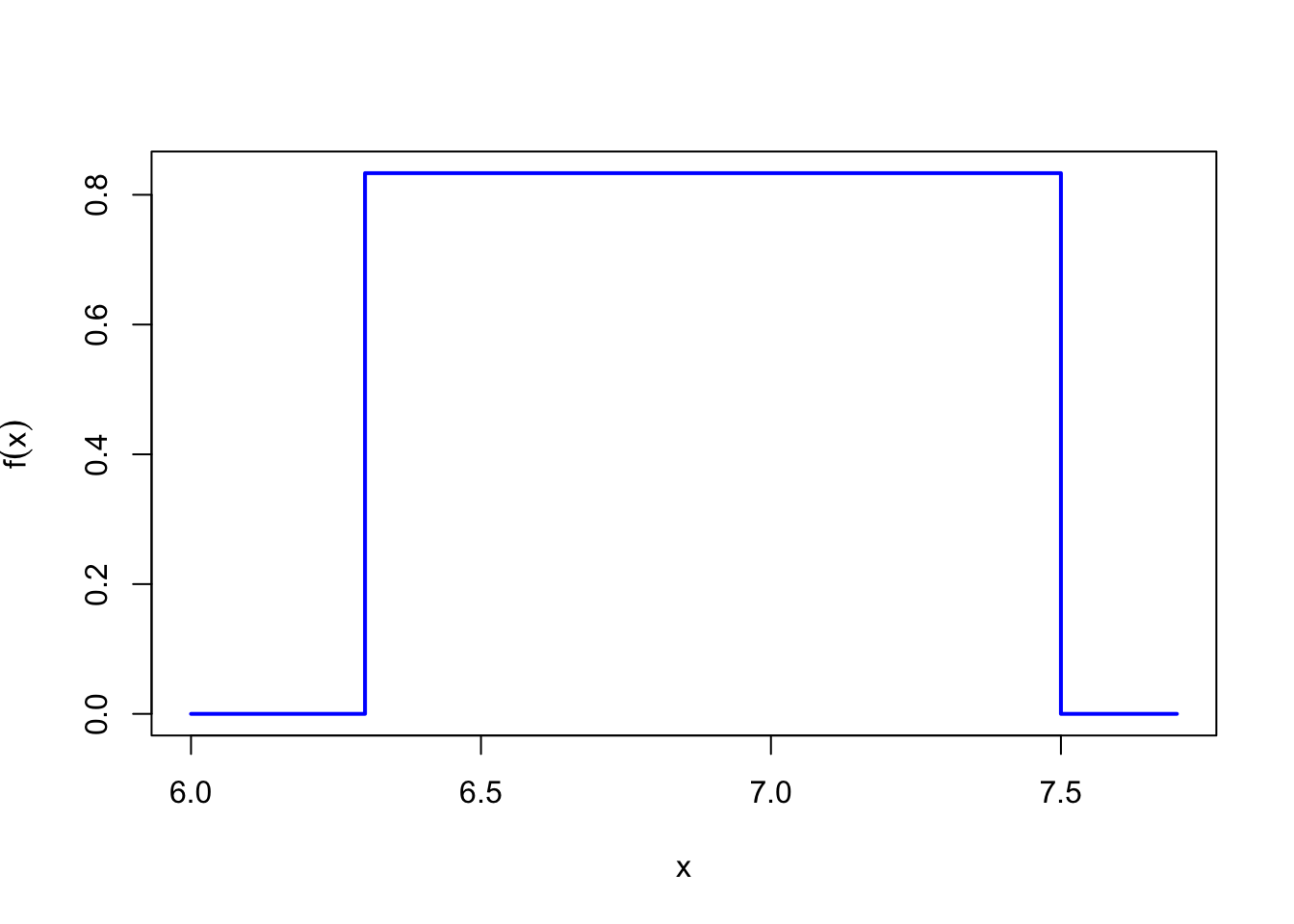
The PDF \(f(x)\) does not represent the probability of the value \(x\); after all, for a continuous random variable, this probability is always zero. Instead, probabilities correspond to areas under the PDF. For example, \(P(7.0 \leq X \leq 7.3)\) is equal to the area of the orange shaded region in Figure 18.5.
In order to define the PDF formally, we first revisit the cumulative distribution function (CDF), which is well-defined for both discrete and continuous random variables.
18.1 Cumulative Distribution Function
Recall from Chapter 8 that discrete random variables can be described by either their PMF or CDF. Although continuous random variables do not have a PMF, they still have a CDF. Recall from Section 8.3 that the cumulative distribution function of a random variable represents the “probability up to \(x\)” and is defined as \[ F(x) \overset{\text{def}}{=}P(X \leq x). \]
Once we have the CDF, it is straightforward to calculate probabilities by plugging in different values for \(x\).
All properties of the CDF from Section 8.3 carry over to continuous random variables:
- non-decreasing with a left limit of 0 and a right limit of 1, and
- right-continuous.
In fact, the CDF of a continuous random variable is not only right-continuous; it is continuous. This is why these random variables are called “continuous” in the first place. Any continuous function \(F(x)\) that satisfies these properties is the CDF of a continuous random variable.
18.2 Probability Density Function
In the introduction to this chapter, we introduced the PDF as the analog of the PMF for continuous random variables. Like the PMF, the PDF \(f(x)\) indicates which values are more “likely” than others, and is often more intuitive than the CDF. In this section, we define the PDF rigorously using the CDF. But we start with an informal definition of the PDF.
18.2.1 Informal Definition
In the hypothetical PDF shown in Figure 18.6, \(f(7.2) > f(6.8)\), so the random variable is more likely to be “near” \(7.2\) than \(6.8\), even though the probability that it is equal to either value is zero.
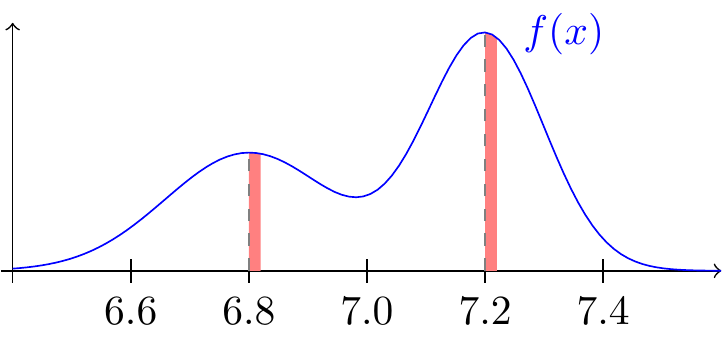
As we will see in Proposition 18.1, probabilities correspond to areas under the PDF. Since there cannot be any area at a single point, \(P(X = 6.8)\) and \(P(X = 7.2)\) are zero. But \(P(6.8 \leq X < 6.81)\) and \(P(7.2 \leq X < 7.21)\) are not zero and correspond to the areas of the red shaded regions in Figure 18.6. By comparing these areas, we can determine that
\[ P(6.8 \leq X < 6.81) < P(7.2 \leq X < 7.21). \] For this reason, we say that \(X\) is more likely to be “near” \(7.2\) than \(6.8\).
18.2.2 Formal Definition
Let’s define the PDF more formally. If we want the PDF \(f(x)\) to describe the probability that the random variable is “near” \(x\), we need the probability that \(X\) is in a small interval \([x, x + \varepsilon)\) to be \[ P(x \leq X < x + \varepsilon) \approx f(x) \cdot \varepsilon. \tag{18.2}\] Notice that this probability gets smaller as \(\varepsilon\) decreases. This makes sense because as \(\varepsilon\) decreases, the probability approaches \(P(X = x)\), which is zero for any continuous random variable.
Now, we can rewrite the left-hand side of Equation 18.2 in terms of the CDF so that Equation 18.2 becomes: \[ F(x + \varepsilon) - F(x) \approx f(x) \cdot \varepsilon. \] Next, we divide both sides by \(\varepsilon\) and take the limit as \(\varepsilon\) approaches 0 (since this is an approximation for \(\varepsilon\) small): \[ \begin{aligned} \underbrace{\lim_{\varepsilon\to 0} \frac{F(x + \varepsilon) - F(x)}{\varepsilon}}_{F'(x)} \approx f(x) \end{aligned} \tag{18.3}\]
This is the basis for a rigorous definition of the PDF \(f(x)\).
18.2.3 Examples
Let’s use Definition 18.1 to determine the PDF of \(X\), the distance that Joyner-Kersee jumps under the model above.
This PDF makes intuitive sense. It is constant between \(6.3\) and \(7.5\) meters to reflect the model’s assumption that Joyner-Kersee is equally likely to jump any distance between \(6.3\) and \(7.5\) meters. It is zero outside of this range because the model assumes that these are the only possible distances. The range where a PDF is non-zero is called the support of the random variable. So the support of \(X\) is \([6.3, 7.5]\).
We can also calculate probabilities using the PDF directly. The next result follows from Definition 18.1 and the Fundamental Theorem of Calculus.
In other words, areas under the PDF correspond to probabilities. The next example shows how we could have solved Example 18.2 using the PDF.
What is the total area under a PDF, \(\int_{-\infty}^\infty f(x)\,dx\)? This is just the probability that the random variable is any real number, which is always 1. This means that it is not necessary to include a scale on the \(y\)-axis; the scale is whatever makes the total area equal to 1.
Together with the requirement that \(f(x) \geq 0\) to avoid negative probabilities, this property defines a valid PDF. That is, any function \(f(x)\) that satisfies the two properties:
- \(\int_{-\infty}^\infty f(x)\,dx = 1\)
- \(f(x) \geq 0\)
could represent the PDF of a continuous random variable.
We can use Property 1 to determine the scale of the PDF when it is not given, as shown in the next example.
18.3 Case Study: Radioactive Particles
In Example 12.7, we introduced the Geiger counter, a device that measures the level of ionizing radiation. It makes a clicking sound each time an ionization event is detected. The clicks occur at random times, and the times at which they occur are well-modeled as a Poisson process. This means that the total number of clicks, counting from time \(0\) to time \(t\), is a random variable \(N_t\), which follows a \(\textrm{Poisson}(\mu=\lambda t)\) distribution, where \(\lambda\) is the rate of clicks. (The higher the value of \(\lambda\), the higher the level of radiation in the air.)
Suppose that we turn on the Geiger counter in a building with \(\lambda = \mean\) clicks per minute. Let \(T\) be the time of the first click (in minutes), measured from the moment that we turned on the device. In Poisson process lingo, \(T\) is called the “first arrival time”.
Now, we can use Definition 18.1 to derive the PDF from the CDF.
So what does the PDF Equation 18.9 look like? Let’s graph it.

We see that at a rate of \(\lambda = \mean\) clicks per minute, the first click is most likely to happen soon after the Geiger counter is turned on, but there is a small (but non-zero) probability that we could be waiting for a long time.
Let’s use the CDF and the PDF to calculate the probability that we need to wait more than \(2.3\) minutes for the first click.
18.4 Calculating the CDF from the PDF
We have seen several examples (Example 18.3, Example 18.7) where we determined the PDF by taking the derivative of the CDF. What if we wanted to go in the other direction? We integrate!
Let’s apply Proposition 18.2 to an example.
18.5 Exercises
Exercise 18.1 (Normalizing Constant I) Let \[ f(x) = \begin{cases} \alpha(2x-x^2), & 0 < x < 2 \\ 0, & \text{otherwise} \end{cases}. \]
- Find \(\alpha\) that makes \(f\) a valid PDF.
- If \(X\) has PDF \(f\), compute \(P(X < 1.5)\).
Exercise 18.2 (Normalizing Constant II) Let \[ f(x) = \begin{cases} \beta(2x-x^2), & 0 < x < 3 \\ 0, & \text{otherwise} \end{cases}. \]
- Is there a \(\beta\) that makes \(f\) a valid PDF?
- If so, compute \(P(2 < X < 3)\), if \(X\) has PDF \(f\).
Exercise 18.3 (When Harry met Sally…) Harry and Sally agree to meet at Katz’s Deli at noon. But punctuality is not Harry’s strong suit; he is equally likely to arrive any time between 11:50 AM (10 minutes early) and 12:30 PM (30 minutes late). Let \(H\) be the random variable representing how late Harry is, in minutes. (A negative value of \(H\) would mean that Harry is early.)
- What continuous model would be appropriate for \(H\)? Write down the PDF and CDF of \(H\).
- Express the event that Harry arrives on time in terms of \(H\) and calculate its probability.
Exercise 18.4 (Benford’s Law) Suppose we have quantitative data, such as stock prices or country populations. What does the distribution of first digits look like? That is, what percentage of observations do you expect to start with the digit 1? What about the digit 9?
If you’ve never tried this, look up a list of stock prices or country populations and count how many start with a 1. It may be more than you expect! This phenomenon is called Benford’s Law.
Here is one model that explains Benford’s Law. Suppose the quantitative data can be modeled by a random variable \(X\) with PDF \[ f(x) = \begin{cases}\frac{c}{x^2} & x \geq 6 \\ 0 & \text{otherwise} \end{cases}.\]
- Determine the value of \(c\) that makes this a valid PDF.
- Calculate \(P(\text{first digit of $X$ is 1})\). (Hint: You will have to calculate the probability of disjoint intervals. These probabilities form a geometric series.)
- Calculate \(P(\text{first digit of $X$ is 9})\) and compare with your answer to b.


